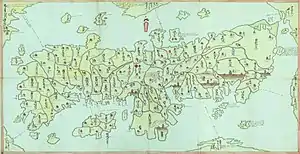Hasunoike Domain
Hasunoike Domain (蓮池藩, Hasunoike-han) was a Japanese domain of the Edo period. It is associated with Hizen Province in modern-day Saga Prefecture.[1]
| Hasunoike Domain 蓮池藩 | |
|---|---|
| Domain of Japan | |
| 1642–1871 | |
| Capital | Hasunoike jin'ya |
| • Type | Daimyō |
| Historical era | Edo period |
• Established | 1642 |
• Disestablished | 1871 |
| Today part of | Saga Prefecture |
In the han system, Hasunoike was a political and economic abstraction based on periodic cadastral surveys and projected agricultural yields.[2] In other words, the domain was defined in terms of kokudaka, not land area.[3] This was different from the feudalism of the West.
History
Hasunoike Domain was originally a sub-domain of the Saga Domain, founded for Nabeshima Naozumi, the fifth son of the first daimyō of Saga Domain, Nabeshima Katsushige. Naozumi was assigned holdings of 52,000 koku. The headquarters of the domain were within the san-no-maru (third bailey) of Saga Castle; later a separate structure, a jin'ya in the Hasunoike district of Saga city was erected.
Hasunoike initially had sankin-kōtai and was treated as if an independent domain. However, in 1730, it petitioned the Tokugawa shogunate to be permitted to stop making the expensive trips to Edo, and was consequently was allowed to attend as part of the retinue of Saga Domain.
During the unsettled Bakumatsu period, the 9th (and last) daimyō of Hasunoike, Nabeshima Naotada was he was ordered the Tokugawa shogunate to take responsibility of the defenses of the Nagasaki area against possible incursions by foreign ships, and was forced to raise and train troops, and build coastal defense fortifications in 1854. This greatly strained the already precarious finances of the domain, which could only be resolved by placing the domain into great debt. In 1864, Naotada dispatched troops to Kyoto to assist the Tokugawa forces in keeping public order. However, during the Boshin War of the Meiji Restoration, he switched sides to the Satchō Alliance and dispatched Hasunoike's forces under the command of his younger brother, against the Ōuetsu Reppan Dōmei and Tokugawa remnants at Akita in support of Emperor Meiji
With the abolition of the han system in 1871, Hasunoike Domain briefly became "Hasunoike Prefecture" before it was merged into the new Saga Prefecture.
In 1884, Naotada and his heirs were granted the title of viscount (shishaku) under the kazoku peerage system.
List of daimyōs
The hereditary daimyōs were head of the clan and head of the domain.
- Nabeshima clan, 1635–1868 (tozama; 52,000 koku)[4]
Name Tenure Courtesy title Court Rank Revenue 1 Nabeshima Naozumi (鍋島直澄) 1642–1665 Kai-no-kami Lower 5th (従五位下) 52,000 koku 2 Nabeshima Naoyuki (鍋島直之) 1665–1708 Settsu-no-kami Lower 5th (従五位下) 52,000 koku 3 Nabeshima Naonori (鍋島直称) 1708–1717 Kai-no-kami Lower 5th (従五位下) 52,000 koku 4 Nabeshima Naotsune (鍋島直恒) 1717–1749 Settsu-no-kami Lower 5th (従五位下) 52,000 koku 5 Nabeshima Naooki (鍋島直興) 1750–1757 Kai-no-kami Lower 5th (従五位下) 52,000 koku 6 Nabeshima Naohiro (鍋島直寛) 1757–1773 Settsu-no-kami Lower 5th (従五位下) 52,000 koku 7 Nabeshima Naoharu (鍋島直温) 1774–1816 Kai-no-kami Lower 5th (従五位下) 52,000 koku 8 Nabeshima Naotomo (鍋島直与) 1816–1845 Settsu-no-kami Lower 5th (従五位下) 52,000 koku 9 Nabeshima Naotada (鍋島直紀) 1845–1871 Kai-no-kami Lower 5th (従五位下) 52,000 koku
Geography
The han territory extended over Kanzaki, Kishima and Fujitsu districts and portions of Matsuura, Saga districts: an area roughly equivalent to modern-day area of Hasunoike district of Saga city in Saga Prefecture, Kyūshū.
See also
- List of Han
- Abolition of the han system
References

- "Hizen Province" at JapaneseCastleExplorer.com; retrieved 2013-5-28.
- Mass, Jeffrey P. and William B. Hauser. (1987). The Bakufu in Japanese History, p. 150.
- Elison, George and Bardwell L. Smith (1987). Warlords, Artists, & Commoners: Japan in the Sixteenth Century, p. 18.
- Papinot, Jacques Edmond Joseph. (1906). Dictionnaire d’histoire et de géographie du Japon; Papinot, (2003). "Nabeshima" at Nobiliare du Japon, pp. 38–39; retrieved 2013-5-30.
External links
- "Kashima" at Edo 300 (in Japanese)